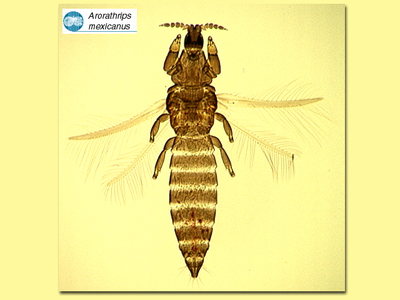Figures
Fig. 1 Head, thorax and abdomen
Fig. 2 Head, pro-, meso- and metanotum
Fig. 3 Fore and hind wing
Fig. 4 Tergite III and IV
Species
Arorathrips mexicanus Crawford
Biology
Breeding only in the florets of certain grasses, each egg is presumably laid within the protection of a glume, and the larva then develops in this protected environment. Pupation also occurs within a floret, and the thrips is thus likely to be distributed within the grass seeds that are supplied commercially.
Distribution
Widespread throughout the tropics and subtropics, including Australia, although probably originally from South America.
Recognition
A small brown thrips with shaded forewings. Head much smaller than the trapezoidal pronotum. Antennae 8-segmented, segment I greatly enlarged, II strongly asymmetric; sense cones on III & IV simple. Foretibia extended around external margin of fore tarsus. Fore coxae greatly enlarged. Mesonotum with two or more rows of small tubercles. Forewing slender and acute. Mesothoracic furca without large lateral wing-like lobes. Tergites with a transverse row of small tubercles along antecostal ridge. Ovipositor small. Male yellow and wingless, sternites III-VII with a large circular glandular area.
Related species
In common with the other 12 members of Arorathrips, all from the New World, the mesothoracic endofurca is greatly reduced and lacks the lateral internal lobes found in the typical thripid pterothorax. These 12 species used to be placed in the genus Chirothrips, but the members of that genus all have the mesothoracic endofurca with pronounced lateral lobes.





